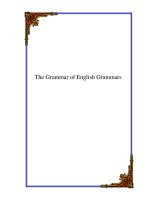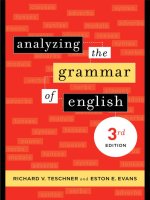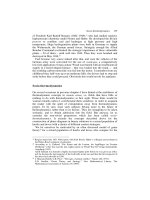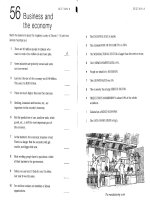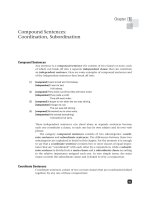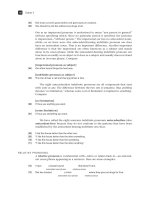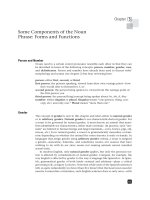Analyzing the Grammar of English Third Edition phần 6 docx
Bạn đang xem bản rút gọn của tài liệu. Xem và tải ngay bản đầy đủ của tài liệu tại đây (259.51 KB, 25 trang )
113
Chapter
5
Some Components of the Noun
Phrase: Forms and Functions
Person and Number
Nouns (and to a certain extent pronouns) resemble each other in that they can
be described in terms of the following concepts: person, number, gender, case,
and definiteness. Person and number have already been used to discuss verbs’
morphology and syntax (see chapter 2) but bear reviewing here:
person: either first, second, or third
first person: the persons speaking, viewed from their own vantage point—how
they would refer to themselves: I, we
second person: the person being spoken to, viewed from the vantage point of
the first person: you
third person: the person/thing/concept being spoken about: he, she, it, they
number: either singular or plural. Singular means “one (person, thing, con-
cept, etc.) and only one.” Plural means “more than one.”
Gender
The concept of gender is new to this chapter and refers either to natural gender
or to arbitrary gender. Natural gender is sex-characteristic-derived gender. For
a noun to be governed by natural gender, it must denote an animal that mani-
fests identifiable sex characteristics, either male or female. (In practice, such “ani-
mals” are limited to human beings and larger mammals—cows, horses, pigs, elk,
moose, etc.) So in natural gender, a noun’s is grammatically masculine or femi-
nine depending on whether the animal the noun denotes is male or female. In
languages that assign gender using arbitrary gender criteria, a noun is assigned
a gender—masculine, feminine, and sometimes neuter—for reasons that have
nothing to do with its sex since nouns not naming animals cannot manifest
sexual traits.
In modern English, only natural gender applies, but only the pronoun sys-
tem is affected by considerations of natural gender. Compare, for example, the
way English is affected by gender to the way a language like Spanish is. In Span-
ish, grammatical gender of both kinds—natural and arbitrary—plays a critical
governing role, as figure 5a shows. Note that while each of the Spanish sentences
tells us quite redundantly (no fewer than five times!) that the head noun maestro/
maestra is masculine or feminine, each English sentence does so only once—with
113-142.Teschner.05.indd 113113-142.Teschner.05.indd 113 4/2/07 6:12:24 PM4/2/07 6:12:24 PM
Chapter 5
114
the predicate’s head noun. For English, its pronoun system (see fig. 5d) does a
much better job of showing how considerations of natural gender and consid-
erations of form interface. All pronoun forms marked for gender appear in bold
type.
Case
Case—introduced in chapter 1—clearly makes itself manifest in figure 5b. By
case we mean the different functions that a form can perform, along with the
differences in form as determined by function. Case then differs from both form
and part of speech, as the following makes clear:
part of speech: what chapter 1 dealt with—whether a word functions as a
noun, pronoun, adjective, verb, adverb, preposition, etc.
case: whether a particular part of speech—for example a noun—is the subject
or the object of the sentence it appears in or, if the object, whether it is the
direct object or the indirect object.
form: the collection of morphemes within a word and how they are arranged
to bring about meaning. (Most salient are the examples from chapter 2:
morpheme /z/ and morpheme /d/ and their various allomorphs.)
English Spanish
The teacher is a very tall man. El maestro es un señor muy alto.
The teacher is a very tall woman. La maestra es una señora muy alta.
The definite article the is the same
for masculine natural-gendered
as for feminine natural-gendered
nouns.
The definite article assumes one
form—el—if the noun is masculine
(maestro ‘[male] teacher’ and thus
masculine gendered for reasons of
natural gender) and another form—
la—if the noun it modifies is feminine
(maestra ‘[female] teacher’) and thus
feminine-gendered for reasons of
natural gender.
The noun itself—teacher—is invari-
ant in form, since no (word-final
morpheme) marks one noun
as masculine and the other as
feminine.
The noun itself is marked as mascu-
line (by the bound inflectional mor-
pheme /o/ at its end) or feminine (by
the /a/ at its end).
The indefinite article a is the same
for masculine as for feminine
natural-gendered nouns.
The indefinite article assumes one
form—un—if the noun is masculine
and another form—una—if the noun
it modifies is feminine.
The adjective (see chapter 6) has
the same form for masculine as for
feminine natural-gendered nouns.
The adjective assumes one form—
alto—if the noun it modifies is mas-
culine and another form—alta—if the
noun it modifies is feminine.
Figure 5a Grammatical Gender: English Compared with Spanish
113-142.Teschner.05.indd 114113-142.Teschner.05.indd 114 4/2/07 6:12:26 PM4/2/07 6:12:26 PM
115
A good illustration of case and its interaction with form is the first person plural
[1.pl.] pronoun. If 1.pl.’s function is to serve as a subject—the doer of the action
or the experiencer of the state—then the form 1.pl. takes is we; if 1.pl.’s func-
tion is that of object—the recipient or “patient” of the action—then us is the
form that 1.pl. takes. If 1.pl. functions as the expresser of possession/ownership
and stands before the possessed noun/the thing owned, then a possessive deter-
miner form is used, but if the indicator of possession constitutes its own noun
phrase, then a possessive pronoun form is taken on. We/us/our/ours then are the
four different forms 1.pl. assumes, depending on what case they are in. These
sentences illustrate each case:
Subject case:
[1] We gave Carolyn the money.
Object case:
[2] Carolyn gave us the money.
Possessive determiner case:
[3] Carolyn gave our money to charity.
Possessive pronoun case:
[4] It was only ours that she gave, not someone else’s as well.
Case
Genitive Partitive
Grammatical: Ungrammatical:
Why don’t you take Jane’s car? *Why don’t you take the car of
Jane?
More preferred/more frequent: Less preferred/less frequent:
He showed me the boy’s new bike. He showed me the new bike of the
boy.
Pete stepped on the cat’s tail. Pete stepped on the tail of the
cat. (“The Tail of the Cat” sounds
like the name of a quaint bar or
restaurant.)
The cop’s favorite food is donuts. The favorite food of the cop is
donuts.
The congregation’s budget was
being discussed.
The budget of the congregation
was being discussed.
As noted, English also prefers the genitive to the partitive even though the Y
possessor is not animate but is viewed as performing an action that involves
a human intermediary. Example:
The plane’s landing took place
under extremely hazardous
conditions.
The landing of the plane took
place under extremely hazardous
conditions.
Figure 5b Genitive versus Partitive in Expressions of Possession
113-142.Teschner.05.indd 115113-142.Teschner.05.indd 115 4/2/07 6:12:27 PM4/2/07 6:12:27 PM
Chapter 5
116
While other persons and numbers can also have four different forms (1.sg., 3.pl.)
or three different forms (2.sg., 2.pl., 3.sg. masculine, and 3.sg. feminine), some
persons and numbers have just two different forms (3.sg. neuter it/its).
Expressing Possession: Genitives and Partitives
When we relate nouns’ forms to the cases they serve in, we see that nouns have
only two cases that can be distinguished from each other by form: genitive and
all other. The “all other” or unmarked case form is the form that English employs
for nouns when they are not genitive. The genitive case is most commonly used
to express possession—X belonging to Y, as in:
[5] Sally’s toothbrush
Y X
[6] Jerry’s hamburger
Y X
However, the genitive case can also be used to express length and measure (a
summer’s vacation [a vacation that lasted all summer]) as well as purpose (the
homosexuals’ concentration camp [a camp established for the purpose of imprison-
ing gays]), origin and agent (Tennessee Williams’ plays [the plays written by Ten-
nessee Williams]), and relationship and association (the national park’s redwood
trees [the redwood trees in the national park]).
In some instances, a genitive construction is semantically equivalent to a
partitive construction. Partitives use of while genitives use ’(e)s or (e)s’. Here is
an example of a genitive and a partitive that mean the same thing and are used
with equal frequency:
[7] The boy’s name is Vincent.
Y X
[8] The name of the boy is Vincent.
X Y
While sentences like (7) and (8) are considered semantically equivalent and used
with equal frequency, the same is not true of pairs like the following:
[9] My aunt’s pen is on my uncle’s desk.
[10] ?The pen of my aunt is on the desk of my uncle.
Sentence (10) sounds stiff, frozen, unnatural, even French (as if it were a lit-
eral translation of the famous nineteenth-century textbook practice sentence La
plume de ma tante c’est sur le bureau de mon oncle). When, then, does English
prefer (or demand) the genitive and when does it prefer/demand the partitive
to express possession, length, measure, purpose, origin, agent, etc.? In general,
English wants the genitive (a) if Y (the possessor) is a human being or a larger
animal, (b) if Y represents a collective noun wherein people constitute the col-
lectivity, or (c) if Y operates through human intervention (though Y may not be
human itself). Otherwise English prefers the partitive. Figure 5b gives examples.
But if the Y possessor consists of a long noun phrase, it is the partitive that is
preferred, even though the Y possessor is human:
113-142.Teschner.05.indd 116113-142.Teschner.05.indd 116 4/2/07 6:12:28 PM4/2/07 6:12:28 PM
117
Less preferred/less frequent More preferred/more frequent
He is that famous all-controlling
president’s confidant.
He is the confidant of that famous all-
controlling president.
And only the partitive can be used in expressions of quantity or quality:
Ungrammatical Grammatical
*He asked for a coffee’s cup. He asked for a cup of coffee.
*I dislike this investigation’s type. I dislike this type of investigation.
In similar fashion, nonanimate and lifeless possessors clearly insist on the
partitive:
Ungrammatical Grammatical
*Money’s love is all evil’s root. The love of money is the root of all evil.
Unfortunately, no hard and fast rules exist for other types of constructions
involving possession. In some cases, the choice between genitive and partitive
becomes an issue of register—genitive if the register is informal, partitive if it is
formal. Here are two examples of that:
Informal register Formal register
Victor Hugo’s novels the novels of Victor Hugo
Madame Curie’s discoveries the discoveries of Madame Curie
Partitive-genitive constructions
A partitive-genitive (par-gen) construction is one that contains both the partitive
of and the genitive ’s/s’, thus:
[11] Any friend of Steve’s is a friend of mine.
[12] A cousin of Sara’s was accidentally shot at the mall.
By including both the partitive and the genitive, a par-gen gives the impression it
is redundant, for such a construction seems to be marking possession twice—once
with ’s/s’, and again with of. While the constraints on using this construction are
still not well understood (thus [11] can be expressed as a partitive alone with no
difference in meaning [Any friend of Steve is a friend of mine], while [12] cannot), it
is nonetheless true that in some circumstances a separate par-gen construction is
necessary to reflect differences in meaning such as the following:
[13] I saw a statue of George Washington.
[14] I saw a statue of George Washington’s.
Sentence (13) refers to a statue that depicts the likeness of Washington, whereas
(14) refers to a statue that once belonged to Washington but may not depict him.
Here is another paired sample that makes the same distinction:
[15] They bought a painting of my aunt.
[16] They bought a painting of my aunt’s.
Expressing Possession: Genitives and Partitives
113-142.Teschner.05.indd 117113-142.Teschner.05.indd 117 4/2/07 6:12:29 PM4/2/07 6:12:29 PM
Chapter 5
118
The par-gen construction requires that the Y possessor be human. Thus we say I
found it in the basement of a friend’s but do not say *I found it in the basement of a
building’s.
Activity 5.1
THINKING IT THROUGH
A. Use the terms person/number/gender/part of speech/case to describe the underlined
words. Also say which words are nouns and which are pronouns.
Example of how to proceed:
X. Where did you find the gun that the perpetrator killed them with?
“You’s person is second, its number is either singular or plural (the context does not
make this clear), its gender is unknowable (the context does not specify), its part of
speech is pronoun and its case is subject.”
1. She told him that I killed the cat.
2. Joan’s mother’s neighbor wanted a wife for her son.
3. As the president was leaving the banquet hall, she ran into a head of state whom she
had not yet had an opportunity to say hello to.
4. The principal ordered his subordinates to “get” all teachers who opposed him.
5. We know we will never be defeated by any other men.
6. Did you lose the can of worms or did you throw it out?
7. I heard them call us.
8. He saw you leave me at Joe’s Bar last night.
B. The following sentences are about to be translated into a language whose nouns show
either natural or arbitrary gender. Tell which underlined nouns show natural gender and
which show arbitrary gender. Explain your decision.
Example of how to proceed:
X. Several elderly ladies rapidly drove their grandchildren’s cars on downtown streets.
“Ladies is natural gender, grandchildren’s is natural gender, and the remaining three
nouns are arbitrary gender.”
113-142.Teschner.05.indd 118113-142.Teschner.05.indd 118 4/2/07 6:12:30 PM4/2/07 6:12:30 PM
119
1. My grandmother sold the house in the city and moved in with my uncle.
2. A psychiatrist stood up and told the speaker off.
3. Many people get lost every year in the subway.
4. The ghost frightened the witch but saved the princess from the dragon.
5. The gentry and the nobility looked down on the serfs and, from the heights of their
castles high above the sea, upon the surf as well.
6. After killing his master and his mistress, the butler wiped the gun with a handkerchief.
C. Some of these sentences use the genitive or the partitive correctly, while others do not.
Point out (1) usages that are ungrammatical, and (2) usages that are grammatical but never-
theless sound unnatural. Explain each decision. Then rewrite the ungrammatical/unnatural
sentences.
Example of how to proceed:
X. This problem’s type came as no surprise to the nephew of my wife. “This problem’s type
is ungrammatical, since only the partitive can be used in expressions of quantity or qual-
ity. The nephew of my wife is grammatical but unnatural: English prefers the genitive if
the possessor is a human being. Rewritten: This type of problem came as no surprise to
my wife’s nephew.”
1. Rebecca’s mother’s family’s youngest generation all died without heirs.
2. The money of my father will all go to the widow of my brother.
3. Happiness’s pursuit is guaranteed by our nation’s constitution.
4. The older son of my favorite next door neighbor turned twenty-one today.
5. The children felt that pleasure’s seeking was all good’s sum.
6. The howling mob’s chief goal was to burn down the decadent aristocrat’s palace.
Expressing Possession: Genitives and Partitives
113-142.Teschner.05.indd 119113-142.Teschner.05.indd 119 4/2/07 6:12:31 PM4/2/07 6:12:31 PM
Chapter 5
120
7. I disapprove of his thinking’s way.
8. In Sam’s expert opinion, the operas of Puccini are the best around.
9. The queen lost it in the attic of the castle’s.
10. The sword of the bodyguard of the queen was impaled on the suit of armor of the myste-
rious and utterly fascinating black knight of song and legend.
WRITING IT OUT
D. Use these phrases in a sentence that you make up.
1. the bee’s knees
2. a touch of the flu
3. Connie’s scholarship
4. no amount of loving care
5. the philanthropist’s generosity
6. the wages of sin
7. her neighbor’s dog
8. a touch of honey
9. the corpse’s smell
10. my grandfather’s inheritance
E. Make up five sentences containing correctly used partitive-genitive constructions.
1.
2.
3.
4.
5.
113-142.Teschner.05.indd 120113-142.Teschner.05.indd 120 4/2/07 6:12:32 PM4/2/07 6:12:32 PM
121
Determiners, Common/Proper Nouns, and Mass/Count Nouns
All nouns are either common or proper. In addition, all common nouns must
be classified according to whether they are being used as mass nouns or count
nouns. Knowing whether a common noun is mass or count will aid us in under-
standing how to use determiners correctly. We will now define and explain these
terms and distinctions.
DETERMINERS
We recall from chapter 1 that determiners consist of three groups: articles,
demonstratives, and possessive determiners. We combine these three under the
single term determiners because all three behave in a similar way: While all
precede nouns, none can assume the comparative or the superlative forms that
adjectives can, and apart from preceding head word nouns, none of them behave
like adjectives (see chapter 6) in other ways either.
The following tree demarcates the tripartite determiners category:
determiners
articles
possessivesdemonstratives
definite indefinite
close to
speaker:
close to
listener: 1.sg.: my 1.pl.: our
2.sg.: your 2.pl.: your
sg. pl.
sg.
pl. sg. pl. sg. pl. 3.sg.m.: his 3.pl.: their
3.sg.f.: her 3.pl. their
the the a, an some this these that those 3.sg.n.: its 3.pl. their
ARTICLES, DEFINITENESS, AND SPECIFICITY
Nouns that co-occur with indefinite articles are either nonspecific or specific. If
the indefinite article + noun refers to something that is unknown (as new infor-
mation) to either the speaker or the hearer, that noun is nonspecific in the sense
that its reference is not yet established: it could refer to anyone or anything.
But if either the speaker or the hearer already possesses knowledge of the entity
(as old information), then the indefinite-article-plus-noun combination is spe-
cific. (Old information is something that you already know about, whereas new
information is something that you have just become familiar with.) These terms
are illustrated in the following story (17–19):
[17] Born and raised in Berwyn, Illinois, but not now living there, Stanley wanted to marry a Czech,
but as he no longer knew any, he hopped on the next plane to Prague to try and meet one.
[The clause beginning with but tells us that as of now the Czech mate is still hypothetical, so a
Czech’s indefinite-article-plus-noun combination is new information that is nonspecific.]
[18] After a month in Prague, Stanley wanted to marry a Czech, but his old-fashioned great-grand-
mother in Brno took one look at her and said, “No way, José!” [Here a Czech refers to an entity
that the speaker—the person telling the tale—now knows or has heard about and that the
subject of the first clause, Stanley, has come to know as well. So even though (18)’s indefinite
article (a Czech) is now specific, it is still new information because we the readers have not yet
checked her out.]
Determiners, Common/Proper Nouns, and Mass/Count Nouns
113-142.Teschner.05.indd 121113-142.Teschner.05.indd 121 4/2/07 6:12:33 PM4/2/07 6:12:33 PM
Chapter 5
122
Nouns co-occurring with definite articles are always specific in the sense that
what they are talking about is assumed to be old information to both speaker
and hearer alike. So to check off our story’s ending:
[19] Thus when Stanley finally had to tell the Czech he couldn’t marry her because his great-grand-
mother disapproved, she bounced right on back to Prague and married someone else.
Activity 5.2
THINKING IT THROUGH
A. Locate all the determiners in the following sentences and then tell what each one is—an
article (definite or indefinite), a demonstrative (close to speaker or close to listener), or a
possessive (and if so then who is the possessor: 1.sg., 2.sg., 3.sg.m., 3.sg.f., 3.sg.n., 1.pl., 2.pl.,
or 3.pl.?).
1. The vet said that her quick brown fox jumped over our lazy sleeping dog.
2. It was a dark and stormy night as his guests left the house for their cars.
3. This horse is faster than any of those other horses on the race track.
4. The professor said that that that that that that modified was misplaced.
5. She told her neighbors that some thieves had broken into their house.
6. An apple a day keeps the doctor away.
B. Identify these sentences’ determiners as either specific or nonspecific.
1. The teenage girl had no idea what to buy for Mothers’ Day, so she went looking for a
compact disk that wasn’t too expensive.
2. She found a disk of the loveliest Bulgarian opera she had ever heard.
3. However, a disk like that cost a fortune, so she bought her mother a CD of hip hop music
by the group 2 Dead 2 Croak.
4. In consequence, her mother had quite a surprise awaiting her, and she returned the disk
to the store the very next day.
WRITING IT OUT
C. Write an original sentence containing each of the following determiners.
1. this
2. its
113-142.Teschner.05.indd 122113-142.Teschner.05.indd 122 4/2/07 6:12:34 PM4/2/07 6:12:34 PM
123
Mass Nouns and Count Nouns
3. our
4. an
5. these
6. a
7. her
8. their
COMMON AND PROPER NOUNS
Proper nouns are known colloquially as “names” and do indeed encompass the
gamut of first, middle, and last names human, humanoid, and nonhuman: Billy
Bob, Bill Gates, Sarita Montiel, Wolfgang Amadeus Mozart, Mrs. Grundy, Machi-
avelli, Batman, Dame Agatha Christie, Darth Vader, Hillary Rodham Clinton,
the Empire State Building, the Eiffel Tower, the Taj Mahal, etc. Proper nouns are
singular unless they refer to copies, imitations (We’ve sold out all the Eiffel Towers
in our gift store), successors (Pamela Vivisect is one of the several new Agatha Christies
of the current generation of British mystery writers), or, less often, plural entities (the
Rocky Mountains). Proper nouns also do not co-occur with determiners except
when the need arises to distinguish one same-named proper noun from another
or to indicate how extremely important the bearer of the name is. Examples:
Joey had a run-in with a cop. [no determiner]
*The Joey had a run-in with a cop. [determiner ungrammatical]
The Joey from Brooklyn had a run-in with a cop, but the Joey from the Bronx
did not. [determiners can distinguish between two people with the same
name]
I’ll have you know that this particular vampire is the Count Dracula, direct from
the forests of Transylvania. [determiner that emphasizes the importance of
the bearer of the proper noun]
Common nouns can be defined in the simplest possible of terms: common
nouns are all nouns that are not proper nouns.
Mass Nouns and Count Nouns
All common nouns function in any given context as either mass nouns or count
nouns. A count noun is any noun that allows pluralization and can be modified
by plural numbers or by quantity words such as many. A mass noun on the other
hand does not allow pluralization and is modified by quantity words like much or
by measurer words or phrases like a cup of or a piece of. What follows is a figure that
sets forth the relationships between mass noun use and count noun use in all pos-
sible environments involving determiners or their absence. When using the fig-
ure, be sure to put it into the wider context of English’s hundreds of thousands of
nouns by keeping this in mind: while nearly all nouns can function as count, only
a handful can function as mass. Count then is the unmarked or default category.
113-142.Teschner.05.indd 123113-142.Teschner.05.indd 123 4/2/07 6:12:35 PM4/2/07 6:12:35 PM
Chapter 5
124
As we see, nouns functioning as mass never pluralize. (Example h has already
been identified as a mass-to-count shift, so in h, the archetypical mass noun meat
no longer is a mass noun, having shifted over to count status.) Nouns function-
ing as mass never co-occur with the singular indefinite article a. Mass nouns,
then, are limited in function to these environments:
no determiner and singular [environment a]
definite article and singular [environment c] •••
some and singular [environment g] •••
Note the ••• symbols. They mark the only two environments—c and g—in which
mass-functioning nouns and count-functioning nouns can overlap. (In all other
environments, mass and count are mutually exclusive.) Count nouns’ environ-
mental spread is much greater. Count nouns occur in all environments except a
(no determiner and singular). Here is a list of the environments in which count
nouns routinely occur:
no determiner and plural [environment b]
definite article and singular [environment c] •••
definite article and plural [environment d]
indefinite article and singular [environment e]
some and singular [environment g]•••
some and plural [environment h]
Mass-to-Count Shifts
As noted above, many nouns that typically function as mass can also function
as count. They do so when denoting (1) a type, kind, or brand of something, or
(2) a portion, a serving, or a unit of something. Here are some examples:
Mass: → → → → → Count:
cheese:
Cheese is made from milk. Swiss is a cheese that is full of holes.
France produces 500 different
cheeses.
gas:
Gas costs extremely little in the
OPEC countries.
Hydrosalostrontium is a gas that is
deadlier than any other.
Among all gasses, only baccilosalate
approaches it in force.
milk:
Milk comes from cows, goats, and
other mammals.
I want three donuts and a milk
to go.
There are so many milks on the mar-
ket today that it’s practically impos-
sible to choose.
chocolate:
Chocolate ranges in color from
off-white to pitch black.
“Would you like a chocolate, little
boy?”
That box contains some chocolates
that I just couldn’t resist.
113-142.Teschner.05.indd 124113-142.Teschner.05.indd 124 4/2/07 6:12:36 PM4/2/07 6:12:36 PM
125
Dual Function Nouns: Nouns That Are Both Mass and Count
As we have seen, many of the essentially mass nouns that can also be used as
counts involve food or liquid.
Dual Function Nouns: Nouns That Are Both Mass and Count
A few English nouns—often those that express abstract concepts—function per-
fectly well in both categories: as either mass or count. A good example is the
noun sin. This order of presentation is identical to figure 5c ’s:
Mass Count
a. Sin is very serious if allowed to
go unpunished.
—————
b. —————
Sins of that sort are very serious if
allowed to go unpunished.
c. The sin of adultery is very
serious.
The sin he committed yesterday is
very serious.
d. ————— The sins he committed yesterday are
very serious.
e. ————— A sin such as adultery is very serious.
f. Some sin is very serious (whereas
other [types of] sin is far less so).
I hear he committed some sin or
other.
g. [mass-to-count shift, so:] Some sins are very serious.
For the most part, sin as a mass noun means “sin in general,” while sin as a count
noun equals “an individual occurrence of sin.” Other nouns that, like sin, are
dual function include death, crime, beauty, life, truth, and education.
Activity 5.3
THINKING IT THROUGH
A. Underline all nouns in the following sentences. Next, classify each as proper or common,
and if common, then classify it as to how it has functioned in the sentence—whether as mass
or as count.
Example of how to proceed:
X. From high atop his pulpit, Father Jack, a priest, condemned both sinners and sin.
“The nouns are: pulpit, Father Jack, priest, sinner, and sin. Father Jack is a proper noun,
while the other four are common nouns. Of those four, pulpit, priest, and sinner are
count nouns while sin is a mass noun.”
1. John and Marsha bought a house last year in Kew Gardens.
2. It had a basement, so they made wine there and then stored it in the darkest corner
possible.
3. John wanted chicken for dinner that night.
113-142.Teschner.05.indd 125113-142.Teschner.05.indd 125 4/2/07 6:12:37 PM4/2/07 6:12:37 PM
Ø [no determiner] the a, an some
Singular a c e g
Plural b d [f] h
Our archetypical mass noun is
meat. Any noun that behaves
like meat is functioning as a mass
noun.
Our archetypical count noun is
husband. Any noun that behaves
like husband is functioning as a
count noun.
a. Meat is good for you. a. *Husband washes the dishes.
b. *Meats are good for you. b. Husbands wash the dishes
while wives dry them.
c. The meat looks good to me (so
go ahead and eat it, but don’t
eat the cheese, which is moldy).
c. The husband washes the dishes
and the wife takes out the
garbage.
d. *The meats are good for you. d. The husbands wash the dishes
and the wives dry them.
e. *A meat is good for you. e. A husband washes the dishes
whereas a wife dries them.
f. ————— f. —————
By definition, singular indefinite articles do not co-occur with plural nouns,
so environment f is an impossibility.
a
g. Some meat is good for you. g. In this scene, some husband
washes the dishes.
Both g-mass and g-count need explanation. G-mass uses some as a quantity
word and not as an indefinite article; here, some (‘a certain amount of’). G-
count employs some in a special, almost idiomatic fashion to mean “any
anonymous and unimportant entity.” Some husband washes the dishes would
appear in a context similar to the following: “As the movie starts, boring
married people stand in a kitchen doing various boring things: some wife is
basting a turkey, some husband is grinding cranberries. . . . ”
h. Some meats are good for you
while others aren’t.
h. Some husbands wash the dishes
while others don’t.
Sentence h-mass is a good example of mass-to-count shift.
Note: a. Two exceptions to this rule are the noun ways (You’ve got quite a ways to go
before you’ll finally get there) and the British bollocks (also bollix): “He really made a
bollocks of it.”
Figure 5c The Mass Noun/Count Noun Distinction: Potential Environments
113-142.Teschner.05.indd 126113-142.Teschner.05.indd 126 4/2/07 6:12:38 PM4/2/07 6:12:38 PM
127
4. The chickens were killed on the chopping block.
5. Marsha plucked their feathers, then spilled their guts into the garbage can and rapidly
washed her hands three times.
6. The theory cannot be proven by any professor.
7. Some fish is what Priscilla would like for the picnic.
8. So then some fish jumped into Priscilla’s net and said, “Well, hi there!”
9. It then tried to get some honey but was stung by some bees.
10. Several different types of tea are imported from China.
11. The teetotaler said he would like a sarsaparilla.
12. Some empty water bottles were left behind at the picnic site.
13. The druggies said they would like some coke.
B. Fill in the blanks with either much or many.
1. I don’t have time left.
2. effort has been expended on this project.
3. He said that workers felt just the way he did.
4. I wanted to tell him that attention was being paid to the problem.
5. Now is the time for good men to come to the aid of the hurricane victims.
6. However, people wouldn’t agree with you.
7. The important thing is for money to be spent.
Dual Function Nouns: Nouns That Are Both Mass and Count
113-142.Teschner.05.indd 127113-142.Teschner.05.indd 127 4/2/07 6:12:39 PM4/2/07 6:12:39 PM
Chapter 5
128
8. loving care is also needed.
9. But so are millions of dollars.
WRITING IT OUT
C. Write one original sentence corresponding to each of the following descriptions.
1. beer as a count noun
2. beer as a mass noun
3. any singular count noun co-occurring with an indefinite article
4. any mass noun not co-occurring with a determiner
5. any plural count noun co-occurring with some
6. any plural count noun not co-occurring with a determiner
7. any mass noun co-occurring with a definite article
8. any plural count noun co-occurring with a definite article
9. any plural count noun co-occurring with an indefinite article
10. a dual function noun that functions here as count
Pronouns
According to the sort of grammar that one studies (or used to study) in elemen-
tary school, pronouns are words that “can replace or refer back to nouns or noun
phrases.” However, this definition is flawed. Consider the following example
sentence:
[20] Tubby bought ten donuts and then he ate them.
As sentence (20) contains no other antecedent for he than Tubby, it is safe to
assume that he is coreferential to Tubby. (Coreferential means that two lexical
items refer to each other—in this case he and Tubby refer to the same person.
Tubby comes first, so it is the antecedent; he, coming second, is subsequent. The
same comments are valid for donuts and them.) In a sentence such as the follow-
ing, however, he has the potential to refer to an antecedent other than Tubby, one
located in an as yet unknown sentence that came before it:
[21] Tubby had to go home because he got sick.
Consider the following expanded contexts:
113-142.Teschner.05.indd 128113-142.Teschner.05.indd 128 4/2/07 6:12:39 PM4/2/07 6:12:39 PM
129
[22] Tubby and Gilbert had planned to stay at Joe’s house until Monday, but suddenly Gilbert experi-
enced severe stomach cramps, so Tubby had to go home because he got sick.
In sentence (22), he clearly refers to Gilbert, not Tubby. In the next sentence,
however—
[23] Tubby, who has a long history of overeating, had to go home because he got sick.
—he can only refer to Tubby. Another reason the elementary school rule about
pronouns replacing nouns is flawed can be arrived at by analyzing the following
two sentences:
[24] The monster screamed loudly, and you screamed even louder.
[25] The drivers were dizzy, so we got out of the bus and waited.
While (24) and (25) are grammatical, they seem a bit illogical: we expect the
monster to keep on screaming in sentence (25) and the drivers to get out and wait
in sentence (26), but for either of those events to happen, the pronouns in the
second part of each sentence would have to be different—[the monster screamed
and then] it screamed even louder in (24), and [the drivers were dizzy, so] they got out
and waited in (25). The fact is that neither (24)’s you nor (25)’s we has an ante-
cedent. This draws our attention to a rule about pronouns and coreferentiality:
only third person pronouns can replace nouns or noun phrases. So by defining
pronouns as “words that can replace nouns or noun phrases,” we must exclude
first and second person pronouns from the category, something we obviously
cannot do. The only solution is to say that because first and second person pro-
noun forms behave (morphologically and syntactically) exactly like third person
pronouns, first and second person forms might as well be looked on as pronouns
too, even though they are never actually “pro” (in place of) a noun.
The sets of pronouns that mostly refer to humans are traditionally termed
personal pronouns, even though one of them—it—will never refer to a human
and the third person plural personal pronoun forms can be either human or non-
human in their referentiality according to context, as the following examples
show:
[26] Those nasty boys got what their aunt said they had coming to them.
[27] The eggs were a mess: their shells were all cracked, and they lay on the floor as the crowd
stepped all over them.
Personal pronoun forms typically reflect differences in case; thus for many sets
of personal pronouns there are different forms for subject, object, and reflexive
and possessive determiner, as figure 5d makes clear.
It will be recalled that a subject is what governs verb agreement, serves as
the antecedent for a regular tag question, and is the first noun phrase to the left
of the auxiliary or of the conjugated LV in a noninverted sentence. An object,
whether direct or indirect, is the recipient of the action of a transitive verb. Not
yet discussed is the difference between the two types of possessives. A posses-
sive determiner bears that name because it functions syntactically like the other
Pronouns
113-142.Teschner.05.indd 129113-142.Teschner.05.indd 129 4/2/07 6:12:41 PM4/2/07 6:12:41 PM
Subject Object Reflexive Possessive
determiners pronouns
number:
person/gender sg pl sg pl sg pl sg pl sg pl
first person I we me us myself ourselves my our mine ours
second person you you you you yourself yourselves your your yours yours
third person:
masculine he they him them himself themselves his their his theirs
feminine she they her them herself themselves her their hers theirs
neuter it they it them itself themselves its their its theirs
Figure 5d The English Personal Pronoun System
113-142.Teschner.05.indd 130113-142.Teschner.05.indd 130 4/2/07 6:12:41 PM4/2/07 6:12:41 PM
131
Pronouns
types of determiners—articles and demonstratives—appearing before the noun
phrase it forms part of (e.g., I lost the/a/that/my new coat yesterday). A possessive
pronoun behaves in a coreferentially pronominal fashion, replacing and refer-
ring back to a noun or noun phrase:
[28] Sandy lost her coat yesterday, and I lost mine on Sunday.
THE MORPHOLOGY OF PERSONAL PRONOUNS
Even a quick glance at the personal pronoun chart we have just presented will
show that case cannot always be determined by form alone. Thus the form you is
either subject or object, as is it and two of the three third person singular posses-
sives, which can function as determiners or pronouns alike; likewise, her is either
an object or a possessive determiner according to context (object: I saw her today;
possessive determiner: I saw her mother today).
Of the twenty-five distinct personal pronoun forms filling forty separate slots
in figure 5d, you is the most ubiquitous, filling four slots: 2.sg./2.pl. subject and
2.sg./2.pl. object. This morphofunctional underdistinctiveness has prompted a
wide variety of popular spoken forms in the 2.pl. slots (both subject and object)
in American English—the regional you-all and y’all (not to be confused with you’ll
‘you will’), you’ns (/júənz/, from you ones), yous (/jz/), youse (/jus/), youse guys,
and the far less stigmatized you guys (applied to men and women alike)—and also
in British (chiefly you lot).
Morphologically, possessive determiners can be distinguished from posses-
sive pronouns by the word-final /s/ in all but one instance (1.sg.). The rule for
converting a possessive determiner into a possessive pronoun is this: to all deter-
miner forms except my, add /s/ to make the pronoun equivalent unless an /s/
ends the form already (as it does in his and its).
REFLEXIVE PRONOUNS
With two exceptions, English reflexive pronouns are formed by combining a pos-
sessive determiner with self if singular or with selves if plural: my + self, her + self,
etc. The two exceptions are himself and themselves, in which the first element of
the compound is the object form and not the possessive determiner. (In some
lects of spoken English, however, the regularizing and stigmatized hisself and
theirselves/theyselves indeed occur.)
Reflexive constructions involve an object (usually direct) that is coreferential to
the clause’s subject. Thus, subject and object are identical in reference. Examples:
[29] Jim shot himself. [= Jim-1 shot Jim-1]
[30] Jackie made herself some eggs. [= Jackie-1 made eggs for Jackie-1]
[31] The goatherds threw themselves from the cliff. [= The goatherds-1 threw the goatherds-1 from the
cliff]
[32] Jane hates herself. [= Jane-1 hates Jane-1]
[33] Why, we just love ourselves to death! [= We-1 love we-1 {us} to death]
English reflexivity can be confusing in the sense that English allows reflexive
concepts (subject and object co-referentiality) to be expressed with nonreflexive
constructions that lack reflexive pronouns. Compare:
113-142.Teschner.05.indd 131113-142.Teschner.05.indd 131 4/2/07 6:12:43 PM4/2/07 6:12:43 PM
Chapter 5
132
[34] François shaved rapidly.
[35] François shaved himself rapidly.
In general, the English rule is this: If it is clear who the reflexive object is—himself
in (35)—then it can be done without—as in (34). It is often the case that a reflex-
ive concept finds itself expressed with a two-word verb (see chapter 4) or with a
got construction (chapter 4), as the following show:
[36] Sally got up and got dressed in a hurry.
[37] All of a sudden Jerry got very sleepy so he lay down and took a nap.
Indeed, certain reflexive concepts appear to reject the reflexive construction, as
can be seen in the following:
[38] *Sally arose herself and dressed herself in a hurry. [The phrase dressed herself is acceptable,
though overly formal, but *arose herself is simply ungrammatical, at least in modern English.]
[39] *All of a sudden Jerry felt tired so he reclined himself and then ensleepened himself. [There simply
is no such verb as *to ensleepen (oneself), and to recline (oneself) sounds odd at best.]
Some reflexive constructions actually do not express reflexive concepts. What
they express instead is emphasis and/or exclusivity, as (40) and (41) will show:
[40] The owner himself built the house. [= The owner built it alone; no one else did so.]
[41] The owner built the house himself. [This means essentially the same as (40).]
In theory, a single clause could contain two reflexive pronouns—one used for
emphasis and the other for coreferentiality:
[42] Josh himself shaved himself.
But while this construction is grammatical, it is stylistically awkward and is more
likely to be:
[43] Josh shaved all by himself. [i.e., today was the first time that this young adolescent succeeded in
shaving himself unaided]
RECIPROCAL CONSTRUCTIONS
Reciprocity means mutuality of action: A does to B what B does to A. The phrases
each other and one another are used to represent it. Thus:
[44] John and Marsha love each other.
[An underlying representation of this would be: John loves Marsha and Marsha
loves John.]
[45] Sandy and Guy would always help one another study for tests.
A constraint on reciprocity is that reciprocal pronouns must appear in the same
clause as their antecedents:
113-142.Teschner.05.indd 132113-142.Teschner.05.indd 132 4/2/07 6:12:44 PM4/2/07 6:12:44 PM
133
[46] *Rich said that Joe thought highly of each other.
Sentence (46) is ungrammatical because it contains two clauses—Rich said [some-
thing] and Joe thought highly of [someone]—and the first antecedent (Rich) appears
in the first clause while the second (Joe) appears in the second clause. For (46) to
be grammatical, it must change to read:
[47] Rich and Joe thought highly of each other.
(47) consists of one clause only: Rich and Joe thought highly . . .
subject verb adverb
Activity 5.4
THINKING IT THROUGH
A. Underline and describe all personal pronouns—subject, object, reflexive, possessive
(including possessive determiners)—in the sentences below. Tell what case each one is in. If
possible, mention person, number, and gender.
Example of how to proceed:
X. We found out from them that his name was the same as hers. “We is a first person plural
pronoun that is in the subject case. Them is a third person plural pronoun that is in the
object case. His is a possessive determiner whose possessor is third person mascu-
line singular. Hers is a possessive pronoun whose possessor is third person feminine
singular.”
1. Perry and Bill packed their bags and took them to the airport so as not to miss their
flight.
2. Sally says she saw her sister Sue save herself a slice of salami.
3. Have you seen your father lately?
4. What’s mine is mine, and what’s yours is yours.
5. All my friends admire each other terribly, but they think even higher of me myself.
6. Sam himself will give us a lift to the airport.
7. Why I declare: y’all’s new pickup is jes’ about as cute as a bug!
8. He up and made himself a mess of greens.
Pronouns
113-142.Teschner.05.indd 133113-142.Teschner.05.indd 133 4/2/07 6:12:45 PM4/2/07 6:12:45 PM
Chapter 5
134
9. They helped themselves to a third dessert.
10. She gave him her hand, and they promised one another eternal love until death did them
part.
B. Each of the following sentences contains something that is either stigmatized or that is
ungrammatical. Find that something, correct it, then explain why it is ungrammatical or (from
the standpoint of prescriptive grammar) stigmatized.
Example of how to proceed:
X. That one is yours and this one is mines. “*Mines should be ‘mine’. While all the other
possessive pronouns end in /s/—yours, his, hers, its, ours, theirs—mine does not, as it
constitutes an exception.”
1. Him and me was late that day.
2. He would have given some to you and I if he’d wanted to.
3. Marco told me that Luigi saw each other in the mirror.
4. They asked himself what they had done wrong.
5. I saw she at the gas station the other day.
6. The animal tried to extract its paw from the trap.
C. Explain the difference in form and meaning between each of the two sentences in the
following pairs.
1. a. I woke up at six.
b. I woke him up at six.
2. a. Sue said Sam saw her swim.
b. Sue said Sam saw her swim suit.
D. In what way is the following sentence potentially ambiguous? Mary was telling me that
Helga wanted to leave when she felt faint.
113-142.Teschner.05.indd 134113-142.Teschner.05.indd 134 4/2/07 6:12:45 PM4/2/07 6:12:45 PM
135
WRITING IT OUT
E. Write an original sentence containing the pronoun or determiner the description refers to
(“n” indicates neuter gender and “f” indicates feminine gender).
Example of how to proceed:
X. 3.sg.n., object: “I found it on the kitchen floor.”
1. 2.sg., subject
2. 3.pl., reflexive
3. reciprocal
4. 1.pl., object
5. 1.sg., reflexive
6. 2.pl., object
7. 3.sg.f., subject
8. 2.sg. possessive determiner
9. 2.sg. possessive pronoun
10. 3.pl. possessive pronoun
F. Write three original sentences containing reflexive pronouns.
1.
2.
3.
G. Write three original sentences containing reciprocals.
1.
2.
3.
DEMONSTRATIVES
As figure 5e makes clear, English has only four demonstratives, which can func-
tion as either determiners or as pronouns. We already know that these words
function as determiners in that they can constitute the first element in a noun
phrase:
Pronouns
113-142.Teschner.05.indd 135113-142.Teschner.05.indd 135 4/2/07 6:12:46 PM4/2/07 6:12:46 PM
Chapter 5
136
the
[48] I must ride
a
horse.
this
⎧
⎪
⎨
⎪
⎩
that
⎫
⎪
⎬
⎪
⎭
This/these/that/those are called demonstratives because they convey a high degree
of specificity and distinctiveness in pointing out (“demonstrating”) a referent;
thus (51) by using a demonstrative makes emphatically clear exactly which apple
is the one desired, whereas (50) though specific is not as emphatic, and (49) is
fully nonspecific:
[49] I want an apple.
[50] I want the apple.
[51] I want this apple.
The near to speaker/near to hearer distinction enables us to differentiate
between sentences such as the following:
[52] I want these apples.
[53] I want those apples.
In (52) the apples are assumed to be closer to the person speaking than to the
person hearing, whereas in (53) the apples are either closer to the hearer than to
the speaker or they are distant from the speaker and the hearer alike.
DEMONSTRATIVE PRONOUNS
So far, all the demonstratives we have seen have functioned as determiners pre-
ceding nouns in noun phrases. But if the noun phrase’s noun is deleted, one of
two things can happen:
a. the deleted noun can be replaced by the antecedent-bearing indefinite pro-
noun one, as in (54) → (55):
[54] I want that apple over there. →
[55] I want that one over there.
b. the deleted noun is not replaced, as in (56) → (57):
[56] I like these cats better than those cats.
[57] I like these better than those.
singular plural
near to speaker this these
near to hearer (or not near to speaker or to hearer) that those
Figure 5e The English Demonstratives
113-142.Teschner.05.indd 136113-142.Teschner.05.indd 136 4/2/07 6:12:47 PM4/2/07 6:12:47 PM
137
In (55), the demonstrative that remains a determiner because it still precedes a
filled slot, one filled with the antecedent-bearing indefinite pronoun one (I want
that one over there), which replaces the deleted noun apple. But in (57), demon-
strative these is a demonstrative pronoun (I like these better . . . ) since it is now
the noun phrase’s sole component. This is because the noun (cats) that follows it
in (56) has been deleted, and nothing has taken cats’ place. (Recall from chapter
1 that all noun phrases must contain either a noun or a pronoun. Lacking both,
a phrase is not a noun phrase but some other kind of a phrase.)
INDEFINITE PRONOUNS
Indefinite pronouns are divided into two categories: (i) the antecedent-bear-
ing indefinite pronoun one (the same “one” appearing just above in sentence
[55] and discussed thereafter), and (ii) the antecedentless indefinite pronouns
(somebody, someone, something, somewhere; anybody, anyone, anything, anywhere)
presented for the first time here. The two categories are listed in the following
chart:
Antecedent-Bearing Indefinite Pronoun:
one
Antecedentless Indefinite Pronouns:
body
how
some one
thing
⎧
⎪
⎨
⎪
⎩
where
body
how
any one
thing
⎧
⎪
⎨
⎪
⎩
where
That antecedent-bearing one takes an antecedent is proven in (58) and (59):
[58] I like this house better than the other one. [Here, one is coreferential with the noun antecedent
house.]
[59] Isn’t Sam the one I met at the bris? [Here one corefers to Sam.]
The word one does not always function as an antecedent-bearing indefinite
pronoun and is therefore ambiguous as to part of speech. In some contexts it
is—as we already know from the previous paragraphs—an antecedent-bearing
indefinite pronoun, in other contexts it is an impersonal pronoun, while in yet
other contexts it is a numeral (as in One and one is two). Here are several examples
of one as an impersonal pronoun:
[60] One lives and learns.
[61] One does the best one can.
Pronouns
113-142.Teschner.05.indd 137113-142.Teschner.05.indd 137 4/2/07 6:12:48 PM4/2/07 6:12:48 PM
